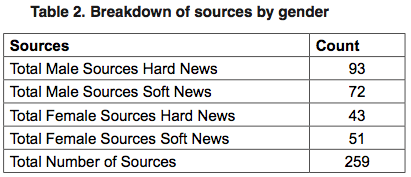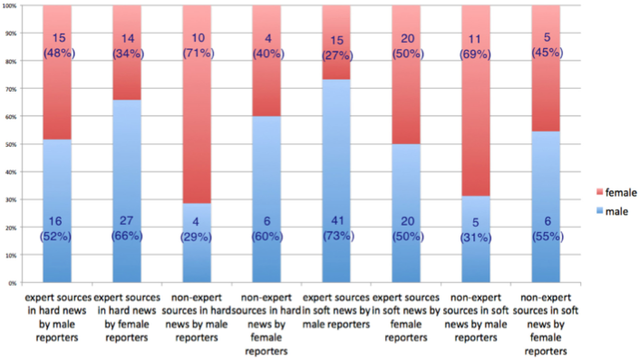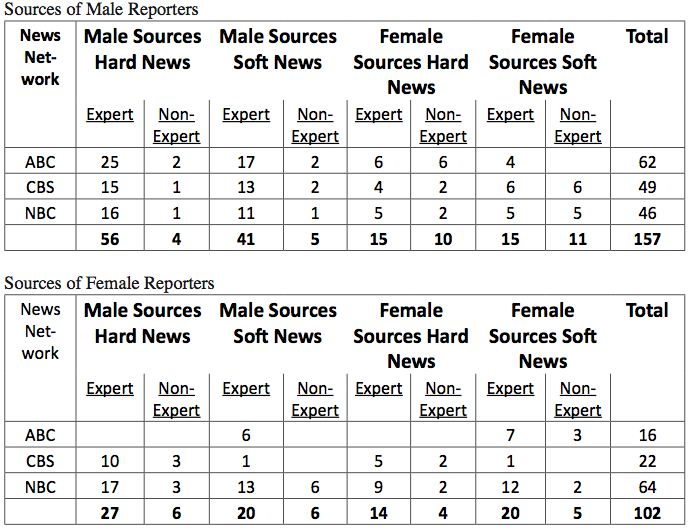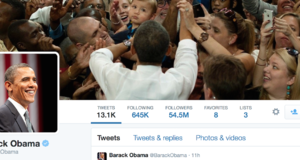From Elon Journal of Undergraduate Research in Communications VOL. 4 NO. 1Women in TV Broadcast News: Reporters and Sources in Hard News StoriesIII. MethodsContent analysis is the systematic, objective, and quantitative collection and analysis of messages taken from media, typically through category assignment. In mass communications research, content analysis has exploded over the past 20 years to become the fastest-growing technique, due to "the rapid advancement of content analysis software, with a corresponding proliferation of online archives and databases... it has never been easier to perform at least basic analyses with computer-provided speed and precision" (Neuendorf, 2002, p. 1-2). Content analysis must be rigorous and systematic in nature (Rosenberry & Vicker, 2009). In any study, research techniques are expected to be reliable and replicable, meaning "researchers working at different points in time and perhaps under different circumstances should get the same results when applying the same technique to the same phenomena. Replicability is the most important form of reliability" (Krippendorff, 2012, p. 24). Content analysis should be able to support the validity of a study's results. This study has collected data on the association between the gender of broadcast reporters and the type of story they are assigned, as well as whether male sources are cited as experts and used more often than female sources. The purpose of this data is to confirm the theory that, during a season of increased political activity, male reporters will continue to be given more hard news stories than their female colleagues, and that male reporters will rely heavily on male sources. This study has analyzed the evening newscasts of the "Big Three" commercial broadcast, non-cable networks, ABC, CBS, and NBC. Over a two-week period of weekday broadcasts, totaling to ten programs studied per network, this study analyzed three similar news programs broadcast from 6:30 to 7:00 P.M. These three news shows were ABC World News with Diane Sawyer, CBS Evening News with Scott Pelley, and NBC Nightly News with Brian Williams. All three shows cover a variety of international and domestic news, as well as hard and soft news, which made them optimal programs to evaluate in this study. Between October 8 and October 19, 2012, all three shows were analyzed each weekday night, except for the October 8 broadcast of CBS Evening News with Scott Pelley, as no data was available. While coding for these news programs, this study focused the coding parameters to meet the specific research questions proposed. This study created precise rules to determine who qualified as a reporter: anchors did not count. Also, this study was concerned with the gender of a reporter and the type of story he or she was reporting, thus making it necessary to define what qualifies as a story. In this study, a full news package counted as a story. A news package is a pre-recorded, self-contained report in which a reporter is shown talking on camera, often filmed on location, that runs for about 1:15 to 2:00 minutes long. Defining a story as a news package ensured that the stories coded in this study were roughly the same length and that reporters had a similar level of involvement in delivering and developing the story. This eliminated news anchors from the coding process, as a news anchor typically read the short news pieces, while a reporter was afforded more time to cover a story in depth and refer to multiple sources. The terms "hard news" and "soft news" also had to be defined more clearly. It was decided that hard news would include stories of political and international nature, especially stories that were time-sensitive, like the story about a would-be bomber in New York. Soft news included health and feature stories, or stories that could be reported at any time of the week without altering their message. The case of the meningitis outbreaks were at first soft news stories, as not much time or many resources were dedicated to developing the stories, until multiple people began to die of meningitis, thus making the issue timely and concerning to the public, so hard news. The second part of this study analyzed whether male or female sources were used more frequently, and whether those sources should be considered experts or non-experts. Experts were considered to be experts in the field of the news being reported, when their expertise was related to the type of news. Nonexperts included men and women asked, largely out of context, his or her opinion on the topic of the news story. Children were not included as sources in this study, nor were political candidates, sources from press conferences or sources filmed for or broadcast on other networks. IV. Findings Table 1 shows that all three networks had a similar number of stories broadcast, 55 or 56, which helped to show the differences between the networks in terms of the gender of reporters and the type of stories they covered.
During this time of heightened political activity, as the United States prepared for the presidential elections, most of the broadcasts analyzed had a story relating to the candidates as the lead story, or even broke coverage into two stories. These stories were often considered to be hard news, except in the instances when the stories were presented with elements of soft news stories. Other hard news stories during this time period included the investigation into the Benghazi, Libya, terror attack and the recovery of a young girl, Malala Yousufzai, who was shot by the Taliban in Pakistan for demanding education for girls. As shown in Table 1, the number of hard news stories reported by men was almost double those stories reported by women (61 vs. 33 stories). When three networks were analyzed individually, CBS and NBC did not show much difference in terms of the assignments of female reporters to hard news. The difference was cased by ABC, which only had one hard news story reported by a woman during that study's time frame, compared to 17 and 15 for CBS and NBC, respectively. Considering that this study was over a short time period, the one female hard news reporter from ABC could be out of the norm; conceivably, there are more women working as reporters for ABC than were featured on the nightly news. In terms of coverage of soft stories, there were more male reporters than their female colleagues (46 vs. 27 stories). However, out of the stories the female journalists did cover, 55% were hard news stories, like male counterparts (57%). This shows that, although female reporters cover fewer hard news stories and stories in general compared to male reporters, they still report more hard than soft news stories. In terms of number of stories rather than percentages, the only category in which women reporters had a higher number of stories than men was in the soft news category for NBC Nightly News with Brian Williams. Overall, women covered 60 total stories while men covered 107, which came to 78% more stories for male reporters. This study demonstrated that men were used as sources more frequently than women on the broadcast news programs during this short time frame characterized by heavy election coverage. Table 2 shows that, out of the 259 sources used over the specified time period, 136 sources were for hard news. Among them 93 sources were male sources (68%) and 43 were female sources (32%). When it comes to soft news, 72 out 123 sources were male sources (59%) and 51 from females sources (41%). This suggests that dependency on male sources is higher in hard news than soft news.
To analyze how male and female reporters used the sources differently, Figure 1 was created. In hard news, female reporters relied on expert males in 66% of the cases while male reporters relied on expert males in 52%. This shows that females relied more heavily on male sources as expert sources (See the first two bars in Figure 1). Even in non-expert sources for hard news, female reporters relied on males far more than male reporters (60% vs. 29%). When it comes to soft news, male reporters relied more heavily on male experts than female reporters did on male experts (73% vs. 50%). On the other hand, male reporters more heavily relied on female nonexperts as sources in their soft news than female reporters (69% vs. 45%). One hypothesis of this study was that women reporters would seek out and rely more heavily on female sources; on the other hand, men would do the same with male sources. A breakdown of a male reporter's sources by gender, news type, and expertise level in Figure 1 showed that both male and female reporters relied more on male sources than female sources in most categories. Even the female reporters relatively more heavily relied on male sources in three categories than their counterparts, except for when they covered soft news and used expert sources. Male reporters used male sources more heavily than female counterparts only when they covered soft news and used expert sources. By network, ABC used a total of 78 news sources, CBS used 71, and NBC used the most, coming in at 110. Broken down by gender, female reporters from ABC World News with Diane Sawyer used the least number of sources, only 16. However, female reporters at NBC Nightly News with Brian Williams used the most sources for either gender at any news program, 64. The male reporters from ABC were a close second with 62 sources (See Appendix for more detail). Figure 1: How male and female reporters used sources in different types of news Suggested Reading from Inquiries Journal
Inquiries Journal provides undergraduate and graduate students around the world a platform for the wide dissemination of academic work over a range of core disciplines. Representing the work of students from hundreds of institutions around the globe, Inquiries Journal's large database of academic articles is completely free. Learn more | Blog | Submit Latest in Business & Communications |





















